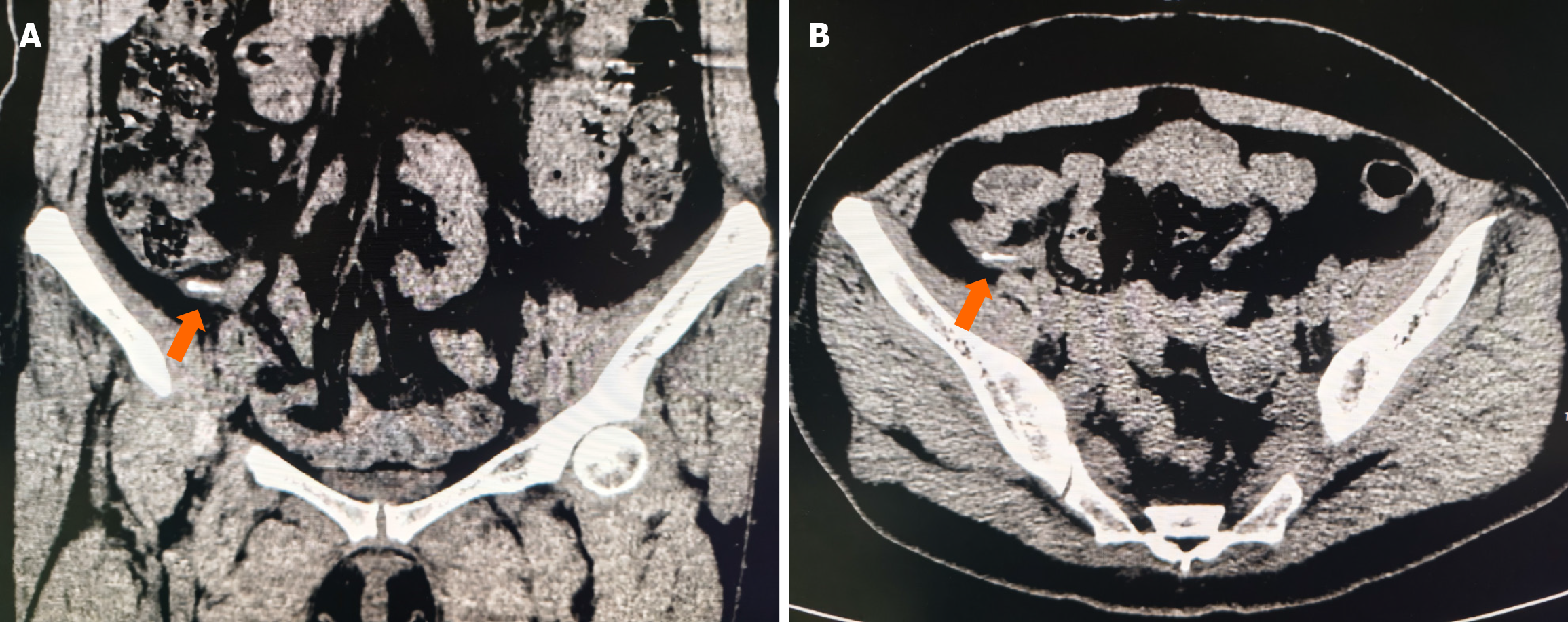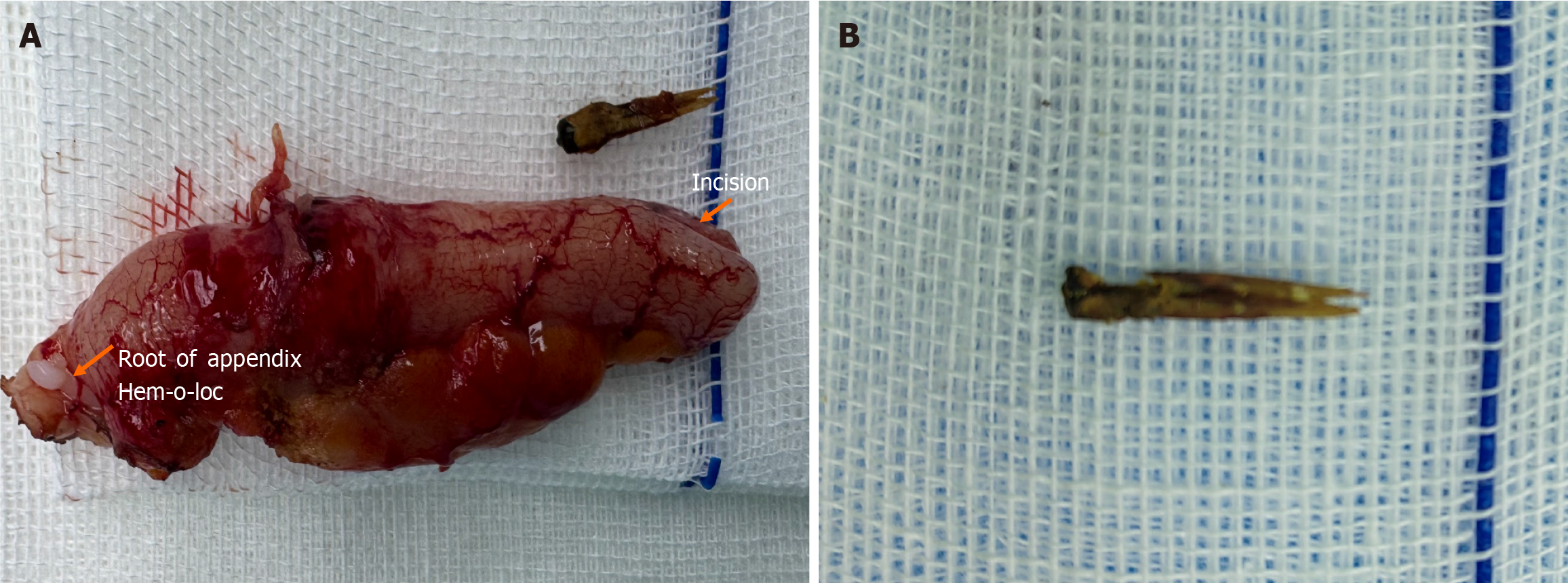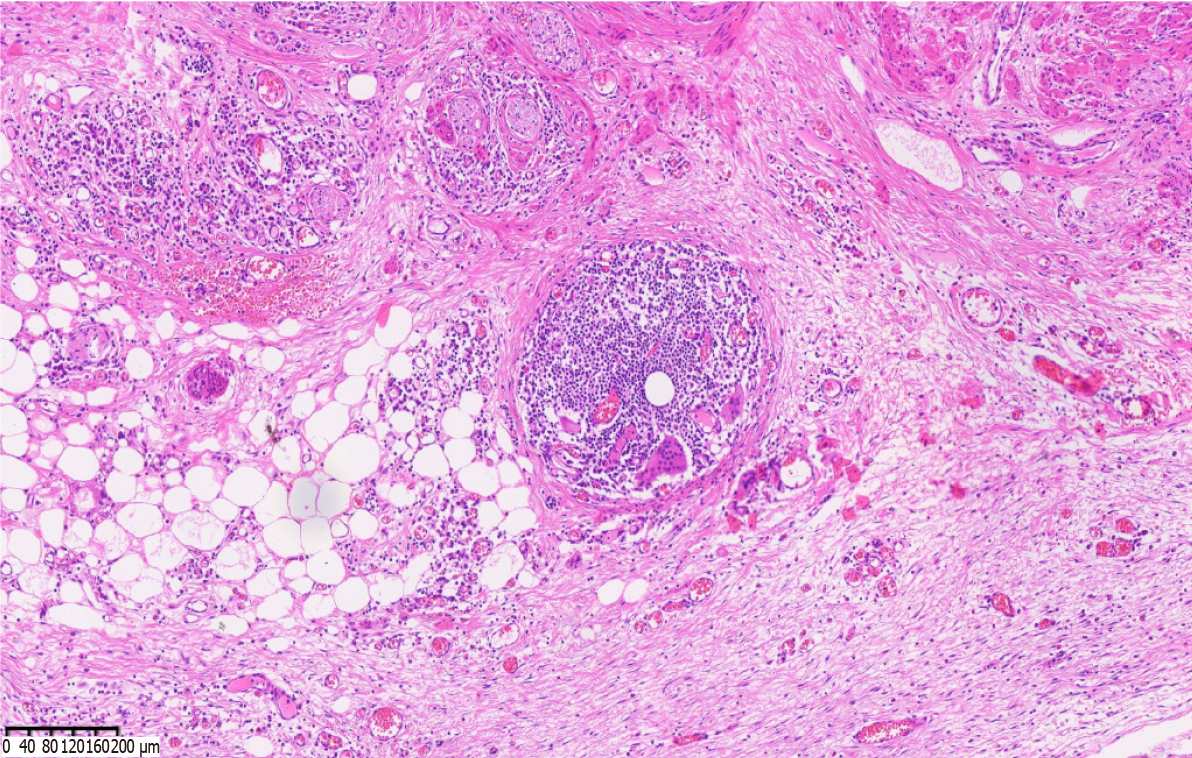Published online May 27, 2025. doi: 10.4240/wjgs.v17.i5.105423
Revised: February 24, 2025
Accepted: March 10, 2025
Published online: May 27, 2025
Processing time: 122 Days and 2.7 Hours
Acute abdominal pain is often easy to be diagnosed because of acute abdomen, and can be treated reasonably and effectively. It is more difficult to establish the cause of chronic abdominal pain, and some patients repeatedly visit several hos
We report an extremely rare case of chronic appendicitis caused by a foreign body in the appendix in a 35-year-old woman. The patient had a long-term abdominal pain of unclear cause, and she was repeatedly treated in several hospitals. After antibiotic treatment, the abdominal pain was gradually relieved, but abdominal pain often recurs. We conducted abdominal computed tomography examination, and upon the advice of radiologists, we considered the possibility of foreign bodies in the appendix, and excluded other causes of abdominal pain. The patient requested and consented to laparoscopic appendectomy, and a chicken bone was found in the appendiceal cavity by postoperative incision of the appendiceal spe
Surgery can relieve chronic abdominal pain caused by foreign bodies in the appendix, but only if it is diagnosed.
Core Tip: We report an extremely rare case of chronic appendicitis caused by a chicken bone in the appendix. The patient was 35-year-old woman, and had a long-term abdominal pain of unknown cause. Abdominal computed tomography examination suggested foreign bodies in the appendix, and laparoscopic appendectomy was performed. The postoperative specimen revealed chicken bones in the appendix cavity, and histopathological examination confirmed chronic appendicitis with giant cell reaction of foreign bodies. The patient recovered and was followed up for two months without abdominal pain.
- Citation: Huang T, Li SK, Wang W, Zhang R. Chronic abdominal pain caused by foreign bodies in the appendix: A case report. World J Gastrointest Surg 2025; 17(5): 105423
- URL: https://www.wjgnet.com/1948-9366/full/v17/i5/105423.htm
- DOI: https://dx.doi.org/10.4240/wjgs.v17.i5.105423
Appendicitis is one of the common diseases that cause abdominal pain[1]. Appendicitis can be diagnosed and treated effectively when patients with acute abdominal pain are admitted to hospital because of factors such as blockage and infection of appendicitis[2,3]. However, the diagnosis of chronic appendicitis is difficult. Acute appendicitis caused by foreign bodies in the appendix is easy to diagnose because of the final surgical treatment[4-6], while chronic appendicitis caused by foreign bodies in the appendix is more difficult to diagnose because of the mild degree of abdominal pain.
We here report an extremely rare case of chronic appendicitis caused by foreign bodies in the appendix. The patient had a long-term abdominal pain of unclear cause, and she was repeatedly treated in several hospitals. Abdominal color ultrasound examination indicated a coprolith in the appendiceal cavity and the appendix was normal, so the patient could not be treated with surgery. We conducted abdominal computed tomography (CT) examination, and upon the advice of radiologists, we considered the possibility of foreign bodies in the appendix, and excluded other causes of abdominal pain. The patient requested and consented to laparoscopic appendectomy, and a chicken bone was found in the appendiceal cavity by postoperative incision of the appendiceal specimen. The patient recovered and was discharged from hospital. After 2 months of follow-up, abdominal pain did not recur and the patient had a full recovery.
Intermittent right lower abdominal pain for > 3 months.
The patient was a woman aged 35 years. The patient presented with right lower abdominal pain for no obvious reason for > 3 months before admission. The degree of abdominal pain was mild, and there was no fever, nausea, vomiting, abdominal distension, or blood in the stools. The patient was admitted to another hospital, but the diagnosis could not be made clearly. In order to make a clear diagnosis, the patient came to the general surgery clinic of our hospital accom
The patient suffered from recurrent episodes of lower right abdominal pain, although the pain was mild, and there was no clear diagnosis in the outpatient department of several hospitals. The abdominal pain could be alleviated by oral antibiotics.
The patient had no significant personal or family medical history.
Physical examination at admission revealed that the skin and sclera were not yellow. The abdomen was flat, the gas
Leukocyte count, neutrophil count, C-reactive protein (CRP) and D-dimer were all normal. Procalcitonin (PCT) was slightly elevated. Blood parameters were as follows: White blood cells 9.01 × 109/L, absolute neutrophil count 5.87 × 109/L, CRP 4.3 mg/L, D-dimer 170 µg/L, and PCT 0.12 ng/mL.
Abdominal CT scan showed high-density imaging in the appendix cavity, which raised the possibility of foreign bodies (Figure 1).
Chronic appendicitis caused by appendicular foreign bodies.
At the request and consent of the patient and her family, laparoscopic appendectomy was performed. During the ope
The preoperative judgment of the operator was accurate, the surgical decision was decisive, the patient recovered smoothly and was discharged from hospital. After 2 months of follow-up, abdominal pain did not recur.
Abdominal pain is one of the most common abdominal symptoms. Acute abdominal pain is often noted by patients because of its rapid onset and severity, and it is easy to diagnosis and treat[7,8]. Chronic abdominal pain mainly presents with mild pain of long duration and lacks typical imaging features. Therefore, it is difficult to identify the specific causes of chronic abdominal pain[9,10]. Most patients have been repeatedly treated in several hospitals but still do not receive effective treatment, and a small number of patients have mental symptoms such as anxiety and depression, which can lead to a decline in quality of life[10]. Chronic abdominal pain caused by chronic appendicitis is such a case. If the degree of abdominal pain is mild and there is no sign of peritonitis, even if chronic appendicitis is diagnosed, surgery is not performed unless the patient strongly requests it. Chronic appendicitis often develops from acute appendicitis.
Acute appendicitis is one of the most common surgical emergencies[1,2], especially in children or older people. Misdiagnosis in emergency situations is likely to delay treatment, leading to serious complications and adverse consequences, which affects the recovery of patients. However, in the case of acute appendicitis, appendiceal mucosal lesions are caused by factors such as blockage of the appendiceal tube and infection, resulting in enlargement of the appendix and peripheral inflammation, which has typical imaging characteristics and is not easy to be misdiagnosed in combination with clinical symptoms and signs[2,3]. On the contrary, chronic appendicitis lacks typical clinical features and imaging findings and is difficult to be definitively diagnosed. The diagnosis of chronic appendicitis is mainly based on medical history. Imaging of the appendix shows a normal structure. Barium enema has some value in the diagnosis of chronic appendicitis, but it has no specificity. If the patient has had acute appendicitis, and the abdominal pain has been relieved by nonsurgical treatment such as antibiotics, the recurrence of similar abdominal pain is considered to be chronic appendicitis. Foreign bodies in the appendix are a rare cause of appendicitis. Under normal circumstances, most foreign bodies ingested orally do not cause abdominal symptoms through the digestive tract, and a few foreign bodies lead to intestinal obstruction, perforation and bleeding. Even fewer foreign bodies accidentally enter the appendiceal cavity and cannot return to the large intestine, resulting in acute appendicitis that is eventually found by surgery. It has been reported that the incidence of acute appendicitis caused by foreign bodies is 0.0005%[5]. The reported foreign bodies include needles, hair, plant materials, magnets[4,5], and even condom fragments[11]. Appendicitis can also be caused by roundworms[12]. However, these foreign bodies all cause acute appendicitis and are eventually found by surgery.
Chronic appendicitis caused by foreign bodies has not been reported to date. We report an extremely rare case of chronic appendicitis caused by foreign bodies in the appendix. The cause of the patient's long-term abdominal pain was still unclear, and she was repeatedly treated in several hospitals. Abdominal color ultrasound examination indicated that there was coprolith in the appendix, the appendix was normal structurally, and the degree of abdominal pain was mild, so surgery could not be performed. After empirical antibiotic treatment, the patient's abdominal pain was gradually relieved, but abdominal pain often recurs. Other reasons, such as chronic enteritis, chronic pelvic inflammation, etc. which may cause chronic abdominal pain were excluded. Abdominal CT examination revealed a high-density image in the appendiceal cavity. According to radiologists, foreign bodies in the appendix were considered instead of coprolith, and laparoscopic appendectomy was performed upon the request and consent of the patient. Postoperative incision of the appendiceal specimen revealed chicken bones in the appendiceal cavity. The patient recovered and was discharged after surgery. Abdominal pain did not recur during 2 months follow-up. Therefore, it is particularly important that we carefully assess imaging findings and multidisciplinary diagnosis when facing atypical symptoms.
Foreign body appendicitis caused by chicken bones entering the appendiceal cavity is extremely rare. Most acute appen
| 1. | Kumar SS, Collings AT, Lamm R, Haskins IN, Scholz S, Nepal P, Train AT, Athanasiadis DI, Pucher PH, Bradley JF 3rd, Hanna NM, Quinteros F, Narula N, Slater BJ. SAGES guideline for the diagnosis and treatment of appendicitis. Surg Endosc. 2024;38:2974-2994. [RCA] [PubMed] [DOI] [Full Text] [Cited by in RCA: 15] [Reference Citation Analysis (0)] |
| 2. | Diaz JJ, Ceresoli M, Herron T, Coccolini F. Current management of acute appendicitis in adults: What you need to know. J Trauma Acute Care Surg. 2025;98:181-189. [RCA] [PubMed] [DOI] [Full Text] [Reference Citation Analysis (0)] |
| 3. | Selvaggi L, Pata F, Pellino G, Podda M, Di Saverio S, De Luca GM, Sperlongano P, Selvaggi F, Nardo B. Acute appendicitis and its treatment: a historical overview. Int J Colorectal Dis. 2025;40:28. [RCA] [PubMed] [DOI] [Full Text] [Full Text (PDF)] [Reference Citation Analysis (0)] |
| 4. | Fuller MY, Leino DG, Reyes-Múgica M, Kovach AE, Velázquez Vega JE, Caltharp S, Bhatti T, Gonzalez RS. Ingested Foreign Bodies Can Cause Appendicitis and Perforation: A Multi-Institutional Case Series. Pediatr Dev Pathol. 2022;25:499-503. [RCA] [PubMed] [DOI] [Full Text] [Cited by in Crossref: 3] [Cited by in RCA: 8] [Article Influence: 2.7] [Reference Citation Analysis (0)] |
| 5. | Hamadneh M, Al-Khalaileh M, Alayed A, Barhoush FR, Hijazin S, Haddad J, Abu-Jeyyab M. Previous Foreign Body Ingestion in the Appendix Causing Acute Appendicitis: A Case Report. Cureus. 2023;15:e34948. [RCA] [PubMed] [DOI] [Full Text] [Cited by in RCA: 2] [Reference Citation Analysis (0)] |
| 6. | Liu PF, Wu YY. Acute appendicitis caused by the fishbone. Asian J Surg. 2023;46:1446-1447. [RCA] [PubMed] [DOI] [Full Text] [Cited by in RCA: 1] [Reference Citation Analysis (0)] |
| 7. | Gulati S, Jana M. Epiploic appendagitis: A case of acute abdominal pain. Indian J Gastroenterol. 2024;43:682-683. [RCA] [PubMed] [DOI] [Full Text] [Cited by in RCA: 1] [Reference Citation Analysis (0)] |
| 8. | Vázquez-Lara SE, Nava JF, Nava-Garza FG, Jimenez-Yarza M, Menchaca-Ramos LG. Acute Abdominal Pain Secondary to Omental Infarction: A Case Report. Cureus. 2024;16:e67694. [RCA] [PubMed] [DOI] [Full Text] [Cited by in RCA: 1] [Reference Citation Analysis (0)] |
| 9. | Nag DS, Swain BP, Anand R, Barman TK, Vatsala. Pain management in chronic pancreatitis. World J Clin Cases. 2024;12:2016-2022. [RCA] [PubMed] [DOI] [Full Text] [Full Text (PDF)] [Cited by in RCA: 2] [Reference Citation Analysis (1)] |
| 10. | Klemm N, Moosavi S. Chronic Abdominal Pain in Patients with Inflammatory Bowel Disease in Remission: A Continuing Challenge for Clinicians. Dig Dis Sci. 2024;69:4336-4346. [RCA] [PubMed] [DOI] [Full Text] [Cited by in RCA: 2] [Reference Citation Analysis (0)] |
| 11. | Sama CB, Aminde LN, Njim TN, Angwafo FF 3rd. Foreign body in the appendix presenting as acute appendicitis: a case report. J Med Case Rep. 2016;10:129. [RCA] [PubMed] [DOI] [Full Text] [Full Text (PDF)] [Cited by in Crossref: 12] [Cited by in RCA: 16] [Article Influence: 1.8] [Reference Citation Analysis (0)] |
| 12. | Khan G, Khan S, Idrees M, Khan H, Faheem H. Foreign Body Appendicitis Coexisting With Ascariasis in a Pediatric Patient: A Case Report. Cureus. 2024;16:e59632. [RCA] [PubMed] [DOI] [Full Text] [Cited by in RCA: 1] [Reference Citation Analysis (0)] |











